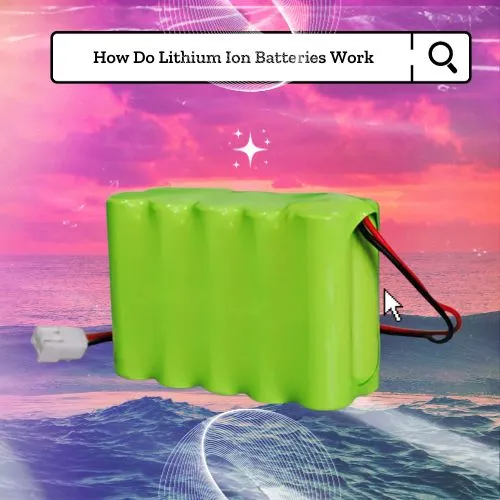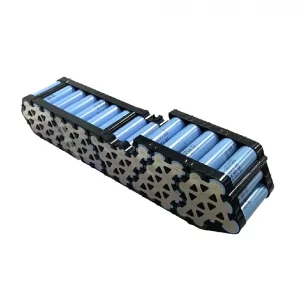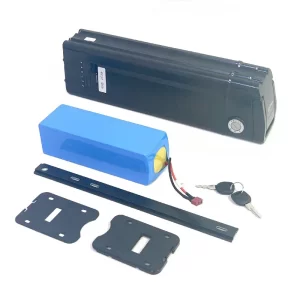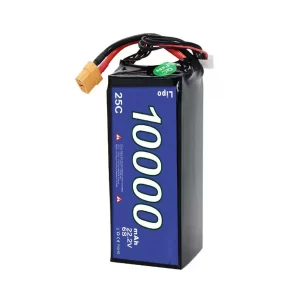This comprehensive guide delves into the intricacies of lithium-ion batteries, the backbone of numerous modern technologies. We’ll explore their fundamental components, underlying chemistry, and operational processes. Additionally, we’ll examine their pros and cons, delve into future developments, and provide tips for prolonging their lifespan. This knowledge will empower you to utilize lithium-ion batteries more effectively in your service to others. Let’s illuminate this indispensable technological marvel together.


How Do Lithium Ion Batteries Work
- Lithium-ion batteries allow lithium ions to move between anode and cathode during charge and discharge cycles.
- External power source applies voltage to push lithium ions from the cathode to the anode through the electrolyte during charging.
- Lithium ions are stored in the anode, charging the battery.
- Lithium ions move from the anode back to the cathode during discharge, releasing energy to power devices.
- This process continues until all ions return to the cathode, requiring a recharge.
- The movement of lithium ions establishes an external circuit for electric current flow.
- Charging and discharging rely on reversible intercalation reactions at the anode and cathode.
- Electrolyte enables lithium-ion transport between anode and cathode.
- The separator prevents short circuits while allowing ion transport.
- Voltage and capacity determine battery power and longevity.
- Proper charging techniques, avoiding overcharging, and optimal storage maximize battery life.
- Battery management systems (BMS) monitor and protect batteries, balance cells, and prevent overcharging and over-discharging.
- Lithium-ion batteries offer high energy density, extended lifespan, low self-discharge, and no memory effect.
- Challenges include environmental impact, recycling difficulties, safety concerns, thermal runaway risk, aging issues, and cost considerations.
- Ongoing research focuses on advancements like solid-state batteries to overcome limitations and improve performance.
- The future holds prospects for higher energy density, faster charging, enhanced safety, and more sustainable materials in lithium-ion technology.

Section 1: Introduction
Since their development, lithium-ion batteries have played a pivotal role in the modern world due to their unique properties and capabilities. Their influence spans various industries where they serve as a vital component in numerous applications. This section will examine their history, significance, and extensive usage.
1.1: Brief history, development, and importance of lithium-ion batteries
The world’s reliance on portable electronic devices has led to the increased volume and rapid development of lithium-ion batteries throughout history. Initially conceived in the 1970s, lithium-ion battery technology has dramatically evolved, becoming essential to our daily lives.
- Brief History: The development of lithium-ion batteries began in the 1970s with the work of chemist M. Stanley Whittingham. However, it wasn’t until the 1990s that they became commercially available.
- Development: Over the years, technological advances have led to the creation of safer, more efficient, and longer-lasting lithium-ion batteries.
- Importance: Today, lithium-ion batteries power many devices, from smartphones and laptops to electric vehicles, illustrating the critical role they play in our technologically advanced society, and understanding how lithium-ion batteries work is essential for future innovation and sustainability.
1.2: Applications and role in various industries
From powering consumer electronics and electric vehicles to storing renewable energy on the grid, lithium-ion batteries play an indispensable role in many industries, becoming a cornerstone of modern energy solutions. Their widespread use is driven by a lithium-ion battery manufacturer’s ability to consistently enhance battery technology and improve battery performance, making these batteries more efficient and reliable. The applications of lithium-ion batteries are diverse and ever-growing, reaching beyond traditional sectors to advanced industries like aerospace, marine, and telecommunications. With the increasing emphasis on sustainability and renewable energy, lithium-ion batteries will continue significantly influencing various sectors, underpinning the transition to a more energy-efficient and environmentally conscious world.

Section 2: Basic Components of a Lithium-Ion Battery
In comprehending the functionality of lithium-ion batteries, we must first understand its essential components. These include the anode, cathode, electrolyte, and separator, each playing a distinct role in the battery’s operation. Our discussion will focus on the function, composition, and materials used in these components, alongside their significance in ion transport and prevention of short circuits.
2.1: Anode: Role, materials used, composition, and function
Understanding an anode’s role, design, and part is crucial to comprehending how lithium-ion batteries operate. The anode is typically composed of carbon, often graphite, acting as a host for lithium ions during the charging process.
- Role: The anode’s leading part in lithium-ion batteries involves storing and releasing lithium ions during charge and discharge cycles.
- Materials and Composition: Active materials such as carbon or metallic lithium are used as the anode. These materials have a layered structure that allows lithium ions to intercalate or de-intercalate during the charging process.
- Function: During charging, lithium ions move from the cathode, through the electrolyte, and into the anode. This ion movement establishes an external circuit, enabling the flow of electric current.
2.2: Cathode: Role, materials used, composition, and function
Equally crucial to the anode in a lithium-ion battery is the cathode, which primarily functions as the lithium-ion receptor during the charging process, and it typically consists of several different materials, including lithium metal oxide. As the positive electrode, the cathode plays a crucial role in the battery’s energy density, with lithium ions moving between the anode and cathode during charge and discharge cycles. Usually, metal oxides like lithium cobalt oxide and manganese oxide are used to make cathodes due to their high energy density. These materials not only facilitate the efficient flow of lithium ions but also contribute to the overall performance and longevity of the battery. Understanding the function and composition of the cathode can assist in improving lithium-ion battery technology.
2.3: Electrolyte: Its function, composition, and role in ion transport
The electrolyte, a vital component in lithium-ion batteries, serves as the medium for lithium-ion transport between the anode and cathode, its composition greatly influencing the efficiency and safety of the storm. This electrolyte solution comprises primarily lithium salts in an organic solvent, facilitating the ion transport crucial to battery functions.
- Ion Transport: The electrolyte solution allows lithium ions to move freely between the negative electrode and the positive electrode material, a process essential for the discharge and charge of the battery.
- Electrolyte Composition: The electrolyte’s composition significantly impacts the battery’s performance and safety. It must withstand high voltage, have a wide temperature range, and remain stable over the device’s lifespan.
- Role in Battery Function: The electrolyte’s primary role is enabling ion transport, but it also provides thermal management and prevents the battery from short-circuiting.
2.4: Separator: Its importance in preventing short circuits and its role in a lithium-ion battery
In a lithium-ion battery, the separator plays an indispensable role in preventing short circuits and ensuring the efficient performance of the storm, acting as a physical barrier between the anode and cathode yet allowing for the necessary ion transport. This delicate balance is crucial for the proper operation of the lithium-ion cells. The separator, while blocking direct electrical connection, enables the flow of electric current through the movement of ions. This functionality is vital in maintaining the integrity of the battery cell and ensuring safety. A failure in the separator can lead to short circuits, causing the lithium-ion battery to overheat or even explode. Therefore, the wall holds a critical position in the design and functionality of lithium-ion batteries.

Section 3: The Chemistry Behind Lithium-Ion Batteries
Now, let us move on to Section 3: The Chemistry Behind Lithium-Ion Batteries. We will explore lithium-ion movement during charge and discharge cycles, the reversible intercalation reactions occurring at the anode and cathode, and unpack the concept of voltage and capacity. This analysis will provide a comprehensive understanding of the chemical processes that underpin the functionality of these vital power sources.
3.1: Lithium-ion movement during charge and discharge cycles
While lithium-ion batteries’ performance depends on many factors, understanding the exercise of lithium ions during charge and discharge cycles is crucial to comprehend their operation and efficiency.
- Charging: When a lithium-ion battery is charged, energy is applied to the anode, which causes lithium ions to move from the anode to the cathode through the electrolyte. This process stores energy in the battery.
- Discharge: When the battery is used, the lithium ions return to the anode, releasing the stored energy and providing power to the device.
- Cycle Life: The efficiency of lithium batteries is measured by the number of complete charge and discharge cycles they can undergo before their capacity falls below a specified level.
3.2: Reversible intercalation reactions at anode and cathode
The anode and cathode of a lithium-ion battery undergo significant reversible intercalation reactions, which are integral to the battery’s ability to charge, store, and discharge energy effectively. These reactions occur when lithium ions are inserted between the layers of the electrodes during charging. As a lithium-ion battery manufacturer, understanding these complex reactions is crucial for improving the efficiency and longevity of rechargeable batteries.
| Electrode | Reversible Intercalation Reactions |
|---|---|
| Anode | Lithium ions are intercalated during charging and de-intercalated during discharging. |
| Cathode | Ions are de-intercalated during charging and intercalated during discharging. |
These reactions involve the movement of charges and are fundamental to the functioning of lithium-ion batteries. Knowledge of these reactions is essential for those who serve others by producing reliable and efficient energy storage systems.
3.3: Understanding the concept of voltage and capacity
To fully comprehend lithium-ion batteries’ functionality, we must delve into the fundamental principles of voltage and capacity, which play pivotal roles in the battery’s performance and efficiency. Understanding the concept of voltage and capacity is essential to grasp the power and longevity of a typical lithium-ion battery.
- Voltage is the electric potential difference between the battery’s two terminals. High voltage increases energy density in lithium cells, positively influencing the battery’s performance.
- Capacity: Refers to the total amount of energy stored in a battery. The power is directly related to the discharge cycles of the storm.
- Internal Resistance: This impacts the charging rate and efficiency of the battery. Low internal resistance allows for faster charging and efficient energy use. Understanding these principles gives us insight into the intricate workings of lithium-ion batteries.

Section 4: Charging and Discharging Process
The fourth section will explore lithium-ion batteries’ charging and discharging processes. We will first investigate how charging impacts the battery’s chemistry and facilitates the movement of lithium ions from the cathode to the anode. Following this, we will discuss the discharging process, focusing on energy release and the migration of lithium ions from the anode back to the cathode.
4.1: How charging affects the battery’s chemistry and the movement of lithium ions from cathode to anode
When a lithium-ion battery is charged, the electrical energy prompts the lithium ions to move back from the cathode to the anode, significantly altering the battery’s chemical composition. This process, fundamental to the functioning of devices such as the Raypower lithium-ion battery, influences battery life and charge density.
- Types of batteries: Lithium-ion batteries, manufactured extensively by lithium-ion battery China manufacturers, vary in energy capacity and lifespan.
- Battery life: The movement of ions during charging and discharging cycles affects the battery’s overall life.
- Charge density: The rate at which lithium ions move during charging determines the charge density, which is essential for the performance of electronic devices.
4.2: Discharging process, energy release, and the movement of lithium ions from anode to cathode
Remarkably, a lithium-ion battery’s discharging process involves releasing stored energy as the lithium ions transition from the anode back to the cathode. This energy release powers our devices and is meticulously engineered by lithium-ion battery manufacturers. During the discharging process, an external circuit connects the anode and cathode, creating a pathway for the movement of lithium ions. As these ions travel from the anode to the cathode, they trigger a reaction that frees electrons. These electrons flow through the circuit, generating an electric current. This carefully controlled movement of lithium ions makes lithium-ion batteries a reliable and efficient power source, demonstrating the high precision needed in manufacturing.

Section 5: Advantages and Disadvantages of Lithium-Ion Batteries
Lithium-ion batteries, as with any technology, present both benefits and challenges. This section will explore, firstly, the advantages, such as their high energy density and extended lifespan, among other attributes. Subsequently, we will address the notable downsides, including environmental implications, safety risks, and cost factors.
5.1: High energy density, longer lifespan, low self-discharge, and no memory effect
Lithium-ion technology stands out in rechargeable batteries due to its high energy density, extended lifespan, low self-discharge rate, and absence of memory effect. These attributes explain how lithium-ion batteries work and why they are preferred for many applications.
- High Energy Density: Current lithium-ion batteries can store substantial energy amounts in a compact space. This feature is indispensable in portable devices like smartphones and laptops that require high energy levels.
- Longer Lifespan: Lithium-ion batteries offer a longer lifespan than other rechargeable batteries. This means they need less frequent replacements, which is cost-effective and environmentally friendly.
- Low Self-Discharge and No Memory Effect: Lithium-ion batteries retain their charge for an extended period, and they don’t suffer from memory effects, meaning they can be recharged at any level without reducing their overall capacity.
5.2: Environmental impact, recycling challenges, safety concerns, risk of thermal runaway, aging issues, and cost considerations
Despite their numerous advantages, lithium-ion batteries pose significant challenges, particularly regarding environmental impact, recycling difficulties, safety issues, risk of thermal runaway, aging problems, and cost considerations. A lithium-ion battery manufacturer faces the ecological effects of mining and processing lithium, leading to habitat destruction and soil contamination. Recycling challenges arise due to battery disposal’s complex procedures and cost considerations. Thermal runaway, a process where an increase in temperature changes the conditions in a way that causes a further temperature rise, can lead to fire and explosions. Furthermore, as the batteries age, their performance declines, raising safety concerns. Despite these challenges, continual research and development aim to mitigate these disadvantages, striving for a safer, more sustainable power solution.

Section 6: Battery Management Systems (BMS)
As we progress in our exploration of lithium-ion batteries, it is crucial to consider the role of Battery Management Systems (BMS). These systems are pivotal in monitoring and safeguarding batteries while preventing potential overcharging and over-discharging. Furthermore, BMS ensures optimal performance by effectively balancing cells within the battery.
6.1: Importance of BMS in monitoring and protecting batteries
While lithium-ion batteries are widely recognized for their high energy density and long lifespan, the Battery Management System (BMS) plays a crucial role in monitoring and safeguarding these batteries from potential harm. The importance of BMS in monitoring and protecting batteries is paramount and cannot be overstated.
- Monitoring: BMS continuously monitors the battery power and state of charge, ensuring that the lithium-ion batteries work within their safe operating area.
- Protection Circuits: BMS employs protection circuits that guard against hazardous situations like overcharging, overcharging, overheating, or short-circuiting, thereby extending the battery lifetime.
- Compatibility: BMS is versatile and can work with various battery types, adjusting its function to the specific requirements of each battery and ensuring optimal performance.
6.2: Overcharging and over-discharging prevention mechanisms
Preventing overcharging and over-discharging, two critical hazards for lithium-ion batteries, requires a well-optimized Battery Management System (BMS), and this section will delve into the mechanisms behind such essential prevention. Understanding how lithium-ion batteries work is critical to enhancing their longevity and safety. A BMS uses overcharging and over-discharging prevention mechanisms to protect the secondary battery. When a battery is overcharged, the BMS disconnects the outer circuit, preventing further cyclable charges from entering the battery. Similarly, during over-discharge, the BMS again breaks the external course to prevent other discharges. These precise control systems ensure that lithium-ion batteries operate safely, consistently, and efficiently under various conditions, ultimately serving users’ needs more effectively.
6.3: Balancing cells to ensure optimal performance
Balancing cells within a lithium-ion battery, an integral component of the Battery Management System (BMS), plays a pivotal role in guaranteeing optimal performance and maximizing battery life. Lithium-ion battery manufacturers, suppliers, and factories focus on the cell balancing process to ensure the longevity of li-ion cells and leverage the advantages of lithium.
- Balancing cells helps in equalizing the charge among all cells. It prevents any single cell from being overcharged or discharged, thus preserving the battery’s overall health.
- Li-ion cells have a high energy density, requiring a precise control system, like BMS, for managing the charge and discharge process.
- Advantages of lithium include lightweight, high energy density, and long cycle life. However, these advantages can only be fully utilized with an optimized BMS that perfectly balances cells.

Section 7: Current Applications of Lithium-Ion Batteries
Due to their high energy density and long cycle life, lithium-ion batteries are integral to a wide array of applications. They are ubiquitous in portable electronics, finding use in devices such as smartphones, laptops, and tablets. Beyond personal electronics, their service has been extended to power electric vehicles and storage systems in renewable energy sectors.
7.1: Portable electronics: smartphones, laptops, tablets
Today’s consumer reliance on portable electronics such as smartphones, laptops, and tablets is primarily powered by the compact efficiency of lithium-ion batteries. These batteries, produced by lithium-ion battery manufacturers, are integral to operating our most essential devices.
- Smartphones: Lithium-ion batteries offer the high energy density required to power complex mobile phone functions, from simple calls to data-intensive applications.
- Laptops: Lithium-ion technology provides longevity in performance, allowing for extended usage without frequent charging.
- Tablets: Lith-ion batteries’ lightweight and slim profile makes them ideal for powering sleek, portable electronics like tablets.
These batteries make our digital, interconnected world possible by fueling our phones, laptops, and tablets with reliable, efficient energy.
7.2: Electric vehicles: cars, bikes, scooters
While portable electronics capture a significant market share, lithium-ion batteries have been instrumental in the rapid growth of electric vehicles, including cars, bikes, and scooters, transforming the transportation industry. Companies like Raypower, a leading lithium-ion battery manufacturer, provide the type of battery crucial to operating these electric vehicles. Their products are sought after in the lithium-ion battery wholesale market due to their longevity, efficiency, and power. These batteries are lauded for their high energy density, providing more hours per kilogram than many other battery types. This has powered our transportation and power tools, allowing for more extended usage and robust operations. Therefore, lithium-ion batteries have become the backbone of our electrified future, driving progress and service in our society.
7.3: Renewable energy storage systems
Remarkably, lithium-ion batteries also play an indispensable role in renewable energy storage systems, facilitating the storage of energy generated by solar and wind sources. Many lithium-ion battery vendors favor them for their impressive cycle life and energy environmental benefits.
- Lithium-ion batteries, especially solid-state batteries, are ideal for renewable energy storage systems due to their high energy density and long cycle life.
- The advancement in lithium-ion technology, such as the development of aqueous solutions, has further improved their safety and performance, thus making them more reliable for renewable energy storage.
- Lithium-ion batteries have the potential to significantly reduce our reliance on fossil fuels, contributing to a cleaner and more sustainable energy future.

Section 8: Future Developments and Challenges
As we turn our attention to future developments and challenges in lithium-ion batteries, several significant points must be considered. Firstly, we will explore advancements in battery technology, particularly solid-state batteries. Then, we will address the current limitations, such as energy density, charging time, and cost, and discuss the critical role of research in driving potential breakthroughs, trends, and improvements.
8.1: Advancements in battery technology: solid-state batteries
One of the most promising advancements in battery technology is the development of solid-state batteries. They offer significant improvements over traditional lithium-ion batteries, presenting a transformative potential to serve many applications, from cell phones to electric vehicles.
- Solid Electrolyte: Unlike lithium-ion batteries, solid-state batteries utilize a solid electrolyte, which enhances safety by eliminating the risk of leaks and fires associated with liquid electrolytes.
- Energy Density: Solid-state batteries have a higher energy density than traditional cylindrical cells, enabling them to store more energy in a smaller space. This makes them ideally suited for compact devices like cell phones.
- Longevity: They also have a longer lifespan, reducing the need for frequent replacements and contributing to a sustainable future.
These advancements in battery technology, solid-state batteries, are driving the next wave of innovation.
8.2: Addressing limitations: energy density, charging time, cost
Despite the significant strides in lithium-ion battery technology, the energy density, setting time, and cost remain critical limitations that require innovative solutions. China manufacturers are leading the charge, investing heavily in research and development to overcome these challenges.
| Limitation | Current Issue | Possible Solution |
|---|---|---|
| Energy Density | Inferior to lead-acid batteries | Development of high-capacity materials |
| Charging Time | Longer than ordinary batteries | Efficient charging algorithms |
| Cost | Higher than acid-electrolyte batteries | Advanced manufacturing techniques |
As a manufacturer, delivering a device that balances performance and cost is crucial. While lithium-ion batteries outperform ordinary batteries in many respects, their limitations often lead consumers to cheaper but less efficient alternatives. With continued innovation, these barriers may soon be a thing of the past.
8.3: Role of research, potential breakthroughs, research trends, and potential improvements
A considerable amount of ongoing research and potential breakthroughs in lithium-ion battery technology are paving the way for significant advancements, addressing existing limitations, and introducing possible improvements that could revolutionize energy storage in the future. According to the Journal of Energy, researchers are focusing on:
- We are developing new oxide materials for the cathode to increase energy capacity.
- We are improving the circuit design to boost efficiency and safety.
- I am finding a safer and more efficient solution to replace the organic solvent in the liquid electrolyte.
These advancements aim to serve society by creating safer, higher-performing lithium-ion batteries. The tireless pursuit of these improvements underscores the quintessential role of research in pushing the boundaries of what’s possible in energy storage technology.

Section 9: Maintenance Tips for Maximizing Battery Life
Specific maintenance steps are crucial to utilize and enhance lithium-ion batteries’ lifespan optimally. These include proper charging techniques to prevent overcharging and storing the batteries under optimal conditions. Furthermore, regular upkeep and battery health monitoring can significantly prolong operational life.
9.1: Proper charging techniques and avoiding overcharging
The charging method can significantly affect the longevity of a lithium-ion battery, and the importance of preventing overcharging cannot be overstated. Suppliers and vendors often provide guidelines for optimal charging to maximize the life of lithium-ion batteries.
- Avoid Overcharging: Lithium-ion batteries do not require a full charge; overcharging can cause damage. Most devices are equipped with a function to stop charging once total capacity is reached.
- Use authorized chargers: Chargers supplied by the factory or authorized vendors ensure the correct current level is used. Unapproved chargers can lead to overheating and battery failure.
- Regular partial charges: Wholesale advice suggests recurring small amounts are preferable to total discharges and recharges. This practice extends the lifespan of lithium-ion batteries.
9.2: Storing batteries at optimal conditions
Maintaining a suitable storage environment is crucial in preserving lithium-ion batteries’ longevity and performance. High temperatures can accelerate the degradation of lithium-ion batteries, while cold temperatures can cause partial discharges. As found in the ACS energy left and, i.e., transactions, storing at optimal conditions can prolong the battery life.
| Battery Condition | Optimal Storage | Source |
|---|---|---|
| High Temperature | Lower than 25°C | acs energy lett |
| Cold Temperature | Avoid partial discharges | ie, transactions |
| Humidity | Dry Environment | ie |
| Charging state | 40-60% charged | ie, transactions |
| Regular Usage | Regular partial discharges | ie, transactions |
9.3: Regular maintenance and monitoring of battery health
Regularly checking your lithium-ion battery’s health and understanding its charge cycles can significantly increase its lifespan and reliability. Lithium, a member of the periodic table, is a critical component in these batteries, used extensively in numerous applications, including medical devices.
- Monitoring Charge Cycles: These batteries have a finite number of charge cycles. Keeping track can help predict when they need replacing.
- Periodic Health Checks: As endorsed by the IEEE Spectrum, regular health checks should be performed. This involves thorough visual inspections and voltage readings.
- Temperature Control: Lithium-ion batteries are sensitive to temperature fluctuations. Ensuring the battery is used and stored moderately can prolong its lifespan.
These practices can contribute to the efficient and safe use of lithium-ion batteries.

Section 10: Conclusion
In the conclusion of this discourse, we shall briefly revisit the key points covered throughout this article. We will also highlight the critical role lithium-ion batteries play in our everyday lives and the impact of their advancements. The future of battery technology, teeming with exciting prospects, will also be briefly touched upon.
10.1: Key points
Throughout this blog post, we have explored five significant aspects of lithium-ion batteries, providing an in-depth understanding of their functionality and importance in modern technology.
- We delved into the fundamental structure of these batteries, highlighting the key components: anode, cathode, and electrolyte, and their roles in energy storage and transfer.
- We discussed the chemical processes within these batteries, particularly the movement of lithium ions during discharge and recharge cycles, and how this facilitates power supply.
- Lastly, we touched upon the significant role of lithium-ion batteries in various fields, including electric vehicles, portable devices, and renewable energy storage systems, emphasizing their contribution to sustainable development and technological advancement. This overview should serve as a concise yet comprehensive recap of our discussion on lithium-ion batteries.
10.2: Importance of lithium-ion batteries in our daily lives
As our society’s reliance on technology grows, so does the importance of lithium-ion batteries, making them an integral part of our daily lives and a cornerstone of modern conveniences. These batteries power our smartphones, laptops, electric cars, and even our homes, enabling us to stay connected, work efficiently, and contribute positively to our environment. Lithium-ion batteries are critical in powering life-saving devices in the medical field, allowing healthcare professionals to serve their patients better. Moreover, their ability to store energy from renewable sources fosters a sustainable future. Hence, the importance of understanding and improving lithium-ion technology cannot be understated. It is vital to a more connected, efficient, and sustainable world.
10.3: The prospects for future advancements in battery technology
While lithium-ion batteries significantly power the current energy landscape, the future holds exciting opportunities for advances in battery technology that will revolutionize how we store and use energy.
- Increased Energy Density: Future batteries will have higher energy density, enabling devices to run longer before needing recharge. This development will positively impact sectors like electric vehicles and renewable energy, benefiting our environment and society.
- Faster Charging: Advanced technology will allow batteries to charge faster, saving substantial time and making electric-powered solutions more convenient.
- Enhanced Safety: Future advancements will focus on improving battery safety, minimizing the risk of overheating and explosions, thus providing a safer environment for users.
These advancements promise a future where energy storage and utilization are more efficient, convenient, and safer, serving the greater good of global communities.

Section 11: FAQs (Frequently Asked Questions)
As we approach the end of our discussion on lithium-ion batteries, it’s crucial to address some frequently asked semantically similar questions. This section will focus on the function of the anode, the charging and discharging process, the components of the battery, the role of the electrolyte, and the benefits of lithium-ion batteries. These points will further clarify the intricate workings of lithium-ion batteries.
11.1: What is the function of the anode in a lithium-ion battery?
The primary part of the anode in a lithium-ion battery is to serve as a host where lithium ions are stored during the discharging process. This process occurs when the battery is providing power to a device.
Here is a list that breaks down the role of the anode:
- Host for Lithium Ions: Lithium ions migrate from the cathode through the electrolyte and are stored in the anode during discharging.
- Electron Provider: When the battery is used, the anode releases these lithium ions and accompanying electrons, generating an electric current.
- Recharging Role: During the charging process, lithium ions are drawn back into the anode, setting the stage for the cycle to repeat.
Understanding the anode’s function is crucial for improving battery technology.
11.2: How do a lithium-ion battery charge and discharge?
You may be wondering how a lithium-ion battery charges and discharges, and in this section, we will unravel this process in detail. During charging, an external power source applies a voltage across the anode and cathode, pushing lithium ions from the cathode through an electrolyte toward the anode. The lithium ions are stored in the anode, which is how the battery is charged.
When the battery discharges, the process reverses. The lithium ions move from the anode through the electrolyte back to the cathode, releasing energy that powers our devices. This process continues until all ions have returned to the cathode, at which point the battery needs to be recharged. Thus, a lithium-ion battery’s charge and discharge cycle is essentially a flow of lithium ions between the anode and cathode.
11.3: What are the components of a lithium-ion battery?
Lithium-ion battery’s structure, which is complex and intricate, includes several key features, and understanding their roles is crucial to grasping how these batteries function.
- Cathode: This is the positive electrode made of lithium metal oxide. It provides the lithium ions during discharge.
- Anode: This is the negative electrode, typically made of carbon-like graphite. It stores lithium ions during the charging process.
- Electrolyte: This is a lithium salt in an organic solvent. It facilitates the movement of lithium ions between the cathode and anode.
Each component has a critical role in ensuring optimal performance and longevity of the battery. It is through the interconnected functioning of these parts that a lithium-ion battery powers our devices, serving our daily energy needs.
11.4: What role does the electrolyte play in a lithium-ion battery?
Acting as a conduit for lithium ions, the electrolyte in a lithium-ion battery is both a vital component and a catalyst, enabling the necessary charge-discharge cycle that powers our electronic devices. It facilitates the flow of ions between the cathode and anode during discharge and reverses the flow during charging. This ion exchange is essential for the battery’s functionality. The lithium ions could not move without the electrolyte, and the energy stored in the storm would remain inaccessible. Its role is akin to a bridge, connecting and enabling interaction between the battery’s other components. Therefore, understanding the electrolyte’s role is crucial to serve others by maintaining their devices. Power. Effective management of this component can significantly increase a battery’s lifespan and efficiency.
11.5: What are the advantages of lithium-ion batteries?
Several distinct advantages make lithium-ion batteries a preferred choice for powering various modern electronic devices. These benefits not only enhance the performance of the devices but also contribute to their longevity and reliability.
- High Energy Density: Lithium-ion batteries offer a significantly increased energy density. This means they can store more energy than other types of batteries of the same size, enabling devices to operate longer between charges.
- Low Self-Discharge: Lithium-ion batteries have a much lower self-discharge rate than other batteries. This preserves the battery’s charge when not in use, extending the overall life of the storm.
- Minimal Maintenance: These batteries require minimal upkeep. They don’t need scheduled cycling to maintain efficiency, offering a hassle-free user experience.

11.6: Are there any safety concerns with lithium-ion batteries?
Despite their numerous benefits, safety concerns exist when dealing with lithium-ion batteries, particularly overheating and the potential for fire or explosion. If not properly managed, these batteries can undergo a thermal runaway process, leading to a self-sustaining reaction, resulting in a significant release of heat and potentially a fire or explosion. This risk is heightened when the battery is damaged, overcharged, or exposed to extreme temperatures. Therefore, anyone handling these batteries, whether in a professional or personal context, must understand how to use, store, and dispose of them safely. Moreover, developing safer lithium-ion battery technologies is critical to ongoing research and innovation.
11.7: How does the separator work in a lithium-ion battery?
In the complex structure of a lithium-ion battery, the division plays an indispensable role by preventing direct contact between the anode and the cathode, thereby averting potential short circuits. This thin piece of insulating material allows the flow of ions and controls the flow of electrons.
- Ion Conduction: The separator is permeable to lithium ions, allowing them to move from the anode to the cathode during discharge and vice versa during charging.
- Electrical Insulation: While it allows ions to pass through, the separator restricts the direct flow of electrons, preventing short circuits.
- Mechanical Separation: It ensures physical separation between the anode and cathode, preventing them from touching each other and possibly leading to battery failure or fire.
11.8: What future improvements can we expect in lithium-ion battery technology?
Undoubtedly, advancements in lithium-ion battery technology are poised to revolutionize energy storage systems, enhancing their capacity and efficiency soon. Scientists and engineers are working tirelessly to make these improvements a reality.
| Potential Improvements | Expected Benefits |
|---|---|
| Greater energy density | Longer battery life |
| Faster charging times | Reduced downtime |
| Improved safety features | Lower risk of overheating and explosions |
| More sustainable materials | Reduced environmental impact |
These advancements will not only benefit end-users but also contribute significantly to global efforts towards energy conservation and environmental sustainability. It is an exciting era for lithium-ion battery technology, and we should all look forward to these advancements’ immense potential.
11.9: Why do lithium-ion batteries age?
To understand the aging process of lithium-ion batteries, it’s essential to delve into the underlying chemical reactions and physical changes that occur throughout the battery’s life.
- Capacity Fade: With repeated charging and discharging cycles, the active lithium in the battery decreases, leading to a reduction in the battery’s ability to store energy, a process known as capacity fade.
- Increase in Internal Resistance: Over time, the electrolyte in the battery degrades, forming a layer of lithium salts on the anode and cathode. This increases the battery’s internal resistance, reducing its efficiency.
- Physical Changes: Expansion and contraction of the battery’s materials during charge-discharge cycles can lead to fractures in the electrode materials, further accelerating aging.
11.10: What are some emerging applications for lithium-ion batteries?
Lithium-ion batteries have found many emerging applications beyond their traditional use in consumer electronics. Increasingly, they are employed in electric vehicles and renewable energy storage systems, where their high energy density and long lifecycle offer significant advantages. Lithium-ion batteries are used in the medical field to power innovative devices such as implantable defibrillators and pacemakers. Grid storage is another area where these batteries are gaining traction, enabling more efficient use of renewable energy sources. Moreover, they are finding applications in the aerospace and defense sectors, powering everything from drones to spacecraft. Lithium-ion batteries serve a growing demand for sustainable, high-performance energy solutions by continually evolving and finding new uses.




